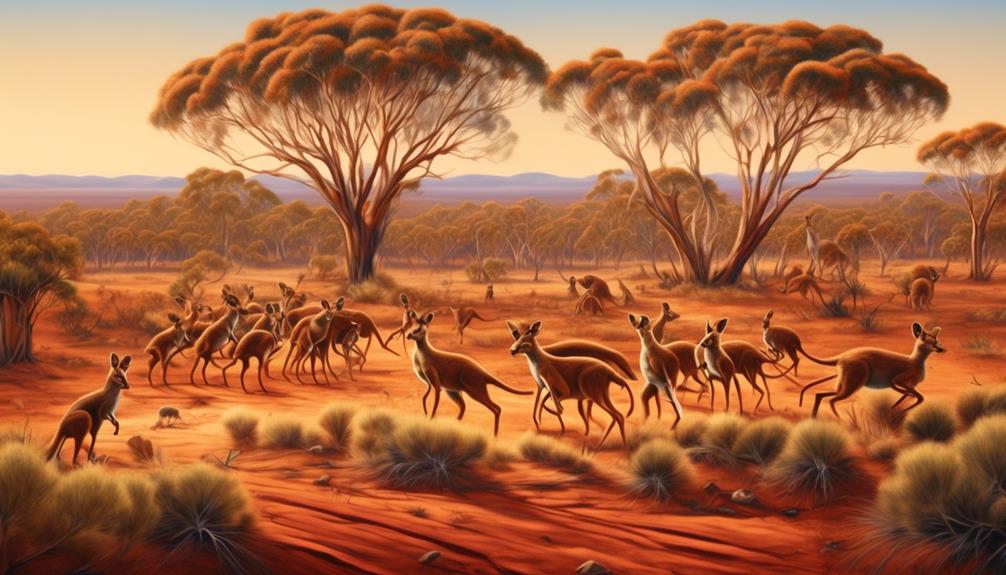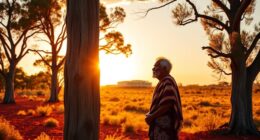Recent genetic studies suggest that Aboriginal Australians can trace their ancestry back around 50,000 years, cementing their status as one of the oldest and most resilient cultures on the planet.
However, the question of where they originated from still remains a subject of intense debate among researchers and scholars. As we explore the various theories and evidence, we may uncover surprising connections and insights that shed light on the ancient origins of this remarkable culture.
Key Takeaways
- Migration to Australia occurred over 50,000 years ago via maritime routes through islands of Southeast Asia, highlighting advanced seafaring skills.
- Aboriginal Australians have a genetic connection with populations of Papua New Guinea, indicating a strong and distinct genetic identity maintained over thousands of years.
- Archaeological evidence, such as ancient artifacts and excavation sites, validates the enduring presence of Indigenous Australians and emphasizes the need for preservation.
- Oral histories and cultural connections, preserved through storytelling and ceremonies, showcase the deep roots of Aboriginal Australian cultural heritage in the land and the importance of preservation for understanding identity and legacy.
Early Human Migration to Australia
The early human migration to Australia occurred over 50,000 years ago and is a subject of considerable interest and ongoing research in the fields of archaeology, anthropology, and genetics. Understanding the prehistoric routes and the movement of ancient settlers to Australia is crucial in unraveling the origins of the Aboriginal Australians. Research suggests that the first inhabitants of Australia arrived via maritime routes, navigating through the islands of Southeast Asia. This migration would have required a deep understanding of seafaring and highlights the advanced skills of these ancient settlers.
The discovery of Mungo Man and Mungo Lady in New South Wales provided crucial evidence of the early presence of humans in Australia. Through archaeological evidence, such as stone tools and rock art, we've gleaned insights into the culture and technology of these ancient settlers. Genetic studies have also shed light on the connections between Aboriginal Australians and other populations, providing valuable information about their origins and migration patterns.
Exploring the prehistoric routes and the movements of ancient settlers to Australia allows us to appreciate the rich history and cultural heritage of the Aboriginal Australians, fostering a deeper understanding of their identity and serving to honor their legacy.
Genetic Studies and Ancestral Links

Using advanced genetic analysis, researchers have uncovered significant ancestral links between Aboriginal Australians and other populations, shedding light on their origins and migration patterns. Genetic studies have revealed that Aboriginal Australians are one of the oldest continuous cultures outside of Africa, with evidence pointing to their presence in Australia for at least 65,000 years. These studies have also indicated a deep genetic connection between Aboriginal Australians and the populations of Papua New Guinea, suggesting a shared ancestry and a common migration route. Additionally, genetic research has shown that Aboriginal Australians have maintained a strong and distinct genetic identity despite interactions with other populations over thousands of years, emphasizing the resilience and uniqueness of their genetic heritage.
The genetic links between Aboriginal Australians and populations in Papua New Guinea evoke images of ancient seafaring journeys across the waters of the Torres Strait, highlighting the remarkable maritime capabilities of these early populations. This connection raises questions about the cultural and technological exchange that may have occurred during these ancient migrations, emphasizing the rich and complex history of the region.
Archaeological Evidence of Indigenous Presence
With the significant ancestral links and genetic connections revealed through advanced analysis, the archaeological evidence of Indigenous presence further illuminates the enduring legacy and rich history of Aboriginal Australians. Ancient artifacts and excavation sites provide vital insights into the deep-rooted culture and traditions of the Indigenous peoples. These artifacts, ranging from tools to rock art, offer a tangible link to the ancestral heritage of Aboriginal Australians. Excavation sites, carefully studied and preserved, unveil layers of history, showcasing the sustainable living practices and spiritual connections to the land that have been upheld for millennia.
| Ancient Artifacts | Excavation Sites |
|---|---|
| Stone tools | Coastal shell middens |
| Rock art | Rock shelters |
| Shell ornaments | Campsites and hearths |
| Wooden implements | Burial sites |
| Basketry and weaving | Ceremonial grounds |
These archaeological findings not only validate the enduring presence of Indigenous peoples but also emphasize the need for their cultural heritage to be respected and preserved. The careful study and documentation of these artifacts and sites are crucial in honoring the rich history and traditions of Aboriginal Australians.
Oral Histories and Cultural Connections

Our exploration of Aboriginal Australian history and culture delves into the invaluable insights offered by oral histories and cultural connections, shedding light on the enduring traditions and societal bonds of this rich and diverse community.
- Oral Traditions: Through generations, the oral traditions of Aboriginal Australians have been meticulously preserved, passed down through storytelling, songs, and ceremonies. These traditions encapsulate the spiritual beliefs, creation stories, and historical accounts of the Aboriginal people, providing a profound connection to their ancestral past.
*Imagery*: Picture a gathering around a campfire, with elders passing on age-old stories to captivated listeners, each narrative intricately woven with wisdom and cultural significance, creating a vivid tapestry of heritage and knowledge.
- Cultural Heritage: The cultural heritage of Aboriginal Australians is deeply rooted in the land, encompassing a profound reverence for nature, traditional practices, and kinship systems. This heritage forms the bedrock of their identity, shaping their values, social structures, and relationships with the environment.
*Imagery*: Envision intricate dot paintings depicting Dreamtime stories, ceremonial dances reverberating through the outback, and the interconnectedness of individuals with the land, evoking a sense of belonging and spiritual interconnectedness.
The preservation of oral traditions and cultural heritage is pivotal in understanding the essence of Aboriginal Australian identity and fostering mutual respect for their enduring legacy.
Theories on Aboriginal Australian Origins
Exploring the enduring oral traditions and cultural heritage of Aboriginal Australians provides a foundation for understanding the diverse theories on their origins. One prominent theory is based on genetic diversity, suggesting that Aboriginal Australians are descendants of one of the oldest continuous cultures on Earth, with genetic links to Africa, Asia, and even the Pacific. This theory is supported by genetic research, which has revealed ancient connections between Aboriginal Australians and other indigenous populations.
Another theory proposes that Aboriginal Australians have deep ancestral connections to the land, dating back tens of thousands of years, and that their origins are intertwined with the geological and ecological history of the Australian continent. These theories aren't mutually exclusive and may complement each other, providing a multifaceted understanding of the origins of Aboriginal Australians.
As researchers continue to investigate and analyze archaeological, genetic, and anthropological evidence, these theories offer valuable insights into the rich and complex history of Aboriginal Australians, contributing to a more comprehensive understanding of their origins and cultural heritage.
Frequently Asked Questions
What Impact Did the Early Human Migration to Australia Have on the Environment and Wildlife?
Early migration to Australia had a significant impact on the environment and wildlife. The arrival of humans altered the landscape through hunting, fire management, and resource utilization, shaping the adaptation of native species. Genetic influence and cultural practices further shaped the ecosystem.
Understanding these interactions is vital for conservation efforts and respecting Aboriginal Australians' cultural identity. This research-driven approach fosters a deeper appreciation of the interconnectedness between humans and the environment.
How Have Genetic Studies and Ancestral Links Influenced Modern Aboriginal Australian Identity and Culture?
Through genetic studies and ancestral links, modern Aboriginal Australian identity and culture have been deeply influenced.
The examination of ancestral connections and genetic markers has provided insights into the rich tapestry of Aboriginal heritage. These studies have given us a deeper understanding of the cultural influences and traditions that have been passed down through generations.
Moreover, they've shed light on the impact of early human migration on the environmental landscape and wildlife, shaping the unique identity of Aboriginal Australians.
What Are Some Examples of Specific Archaeological Evidence That Support the Presence of Indigenous Australians in Ancient Times?
Archaeological findings, indigenous artifacts, and ancient settlements provide compelling evidence of the enduring presence of Indigenous Australians.
Human impact is evident through environmental changes, reflecting their deep connection to the land.
Genetic ancestry, cultural heritage, and oral traditions further affirm their ancient lineage.
Alternative theories are considered, yet the richness of archaeological evidence reinforces the profound and enduring legacy of Indigenous Australians in their ancestral lands.
How Do Oral Histories and Cultural Connections Contribute to the Understanding of Aboriginal Australian Origins?
Oral traditions and cultural connections provide invaluable insights into Aboriginal Australian origins. These narratives, passed down through generations, offer a unique perspective on ancestral links and historical events.
When combined with genetic studies, they enrich our understanding of the diverse origins and migration patterns of Indigenous Australians.
Are There Any Alternative Theories on Aboriginal Australian Origins That Have Gained Traction in Recent Years?
Controversial theories about Aboriginal Australian origins have gained traction in recent years, spurred by genetic studies and ancient migration patterns. These alternative perspectives challenge traditional narratives, highlighting the complexities of cultural connections and historical migrations.
Conclusion
In conclusion, the origins of Aboriginal Australians are a fascinating and complex topic. Evidence points to early human migration, genetic studies, archaeological findings, oral histories, and cultural connections. Theories on their origins continue to evolve, adding to the rich tapestry of their history. Understanding and respecting the diverse origins and connections of Aboriginal Australians is essential in appreciating their unique cultural heritage and contribution to the world.









